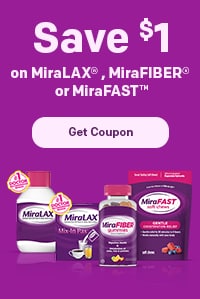Eating is probably the last thing you want to think about when you’re constipated, especially if you’re dealing with symptoms like discomfort, nausea and abdominal pain. But now is the time to be mindful about what you eat and drink — and what you should avoid.
The information provided on this site is for educational purposes only and is not a substitute for professional medical advice. Please consult a healthcare professional for medical advice, diagnosis and treatment.
What Foods Are Good for Constipation?
The path to gutlightenment begins with healthy food choices and good hydration. Let’s look at some steps that can help get you there.
Eat High-fiber Foods
There are two types of fiber, both sourced from plants: soluble fiber and insoluble fiber. Fiber aids in digestion, which is one of the reasons the USDA recommends a high-fiber diet to help with constipation..
Filling up on a variety of high-fiber foods can help you get both soluble and insoluble fiber. The U.S. Department of Agriculture (USDA) recommends that healthy adults get a minimum of 14 grams of dietary fiber for every 1,000 calories they consume. This amount varies with age:
- Adult females: at least 21-25 grams
- Adult males: at least 30-38 grams
- Females ages 9-18: about 26 grams
- Males ages 9-18: 31-38 grams
- Children ages 1-8: 19-25 grams
If you buy packaged foods, look at the nutrition labels and check for 2 grams or more of dietary fiber — this can help you reach the recommended amount of fiber per day.
Reach for Hydrating Beverages and Soups
Staying hydrated by drinking plenty of water supports your overall health and can help you avoid constipation by making your stools softer and easier to pass.
Boost your hydration with liquids like:
- Clear soups
- Herbal teas
- Sports drinks with electrolytes
- Coconut water
- Naturally sweetened fruit and vegetable juices
Some studies indicate that drinking warm water with lemon in the morning may help your body break down foods.
Operation Unblock: A Grocery List for Relieving Constipation
Time to head to the store! Add these high-fiber foods and snacks to your cart to increase your fiber intake and help avoid constipation symptoms.
High-Fiber Foods and Snacks
Which Foods Cause Constipation?
While some foods can help you ease and avoid constipation, others may aggravate it. It can be helpful to track your eating habits so you can evaluate the foods you eat and whether they might be contributing to your backed-up gut.
Here are some foods to avoid when constipated:
- Alcohol, which can cause increased urination leading to dehydration
- Refined sugars and processed grains, which are low in fiber
- Dairy products, which may cause constipation in people who are lactose intolerant
- High-fat meats, which have no fiber
- Highly processed and fried foods, which are often high-fat, low-fiber and contain high amounts of sodium
Keep in mind that people respond differently to various foods depending on their unique health needs. Not sure if something you’re eating may be causing constipation? Talk to your doctor.
-
National Institute of Diabetes and Digestive and Kidney Diseases. Eating, diet, & nutrition for constipation. Updated May 2018. Accessed March 9, 2023. https://www.niddk.nih.gov/health-information/digestive-diseases/constipation/eating-diet-nutrition.
-
Anderson JW, Baird P, Davis RH, Ferreri S, Knudtson M, Koraym A, Waters V, Williams CL. Health benefits of dietary fiber. Nutr Rev. 2009;67(4): 188-205. doi: 10.1111/j.1753-4887.2009.00189.x. Accessed March 13, 2023. https://pubmed.ncbi.nlm.nih.gov/19335713/.
-
University of California San Francisco. Constipation. Accessed March 9, 2023. https://www.ucsfhealth.org/education/constipation.
-
Ruwa R, Healthgrades. 7 foods that can cause constipation. Updated December 21, 2022. Accessed March 9, 2023. https://www.healthgrades.com/right-care/digestive-health/foods-that-cause-constipation.
-
Diaz S, Bittar K, Mendez MD. Constipation. Treasure Island, FL: StatPearls Publishing; 2022. Accessed March 9, 2023. https://www.ncbi.nlm.nih.gov/books/NBK513291/.
-
USDA Dietary Guidelines for Americans. Food sources of dietary fiber. Accessed March 27, 2023. https://www.dietaryguidelines.gov/resources/2020-2025-dietary-guidelines-online-materials/food-sources-select-nutrients/food-0.
-
C.S. Mott Children’s Hospital. Fiber in foods chart. Accessed March 27, 2023. https://www.med.umich.edu/mott/pdf/mott-fiber-chart.pdf.
-
Healthline. Top 20 foods high in soluble fiber. Accessed March 27, 2023. https://www.healthline.com/nutrition/foods-high-in-soluble-fiber.
-
Mayo Clinic. Dietary fiber: essential for a healthy diet. Accessed March 27, 2023. https://www.mayoclinic.org/healthy-lifestyle/nutrition-and-healthy-eating/in-depth/fiber/art-20043983.
-
USDA Food Data Central. Accessed March 27, 2023. https://fdc.nal.usda.gov/fdc-app.html#/.
-
USDA WIC Works Resource System. Eye on nutrition: fiber. Accessed May 18, 2023. https://wicworks.fns.usda.gov/resources/eye-nutrition-fiber.
-
USDA. Dietary guidelines for Americans 2020-2025. Accessed May 18, 2023. https://www.dietaryguidelines.gov/sites/default/files/2021-03/Dietary_Guidelines_for_Americans-2020-2025.pdf.
-
AskUSDA. How much (dietary) fiber should I eat? Accessed May 18, 2023. https://ask.usda.gov/s/article/How-much-dietary-fiber-should-I-eat.
-
Freitas D, Boué F, Benallaoua M, Airinei G, Benamouzig R, Lutton E, Jourdain L, Dubuisson R, Maître X, Darrasse L, Le Feunteun S. Glycemic response, satiety, gastric secretions and emptying after bread consumption with water, tea or lemon juice: a randomized crossover intervention using MRI. Accessed May 18, 2023. https://pubmed.ncbi.nlm.nih.gov/35013789/.
*Per recommended serving. Compared to leading brands.






